Crypto Arbitrage in the U.S. (2025): Real Strategies, Bots, and Platforms That Actually Work
Crypto Arbitrage in the U.S. (2025): Confessions of a Shadow Trader
Written by: An anonymous crypto arbitrageur who’s been flipping spreads since Mt. Gox was a thing.
Let’s get one thing straight — crypto arbitrage isn’t dead. It’s just evolved. In 2025, the U.S. market is flooded with bots, latency-sensitive traders, and exchanges trying to out-fee each other. But if you know where to look, how to move, and when to strike, there’s still alpha to be found. I’m not here to sell you a dream — I’m here to show you how I hunt spreads, dodge fees, and stay ahead of the curve.

The Hustle: What Crypto Arbitrage Is and Why It Still Works
Arbitrage is simple in theory: buy low on one exchange, sell high on another. The difference — aka the spread — is your profit. But in practice, it’s a race against time, bots, and volatility. In the U.S., where regulation is tightening and fees are sneaky, you need precision and lightning speed.
This is basically flipping coins — literally. You buy crypto on one venue where it’s cheaper, and sell it on another where it’s pricier. That price gap is the arbitrage spread. For example, if Bitcoin is trading at $113,800 on Tapbit and $114,100 on Bybit, that $300 spread is your target margin.
Three Main Types of Arbitrage
- Spatial Arbitrage (The Classic Flip): Between two different exchanges (e.g., Binance vs. Tapbit). This relies heavily on transfer speed (network latency).
- Triangular Arbitrage (The Internal Loop): Within a single exchange, using three currency pairs to profit from minor inefficiencies (e.g., trading BTC/ETH → ETH/USDT → USDT/BTC). This is a pure bot game.
- P2P Arbitrage (The Regulatory Gap): Between centralized exchanges and peer-to-peer platforms. This involves managing fiat on/off ramps and local demand differences.
My Shadow Setup: Tools, Speed, and Risk Management
I run a hybrid setup — part manual, part automated. Speed (low latency) is non-negotiable in 2025.
- 3Commas / Custom Python Bot: For 24/7 bot execution and immediate spread alerts. Automation is key to capturing ephemeral spreads.
- Google Sheets + API: For custom tracking and real-time fee calculation. Never trust an exchange’s advertised fee structure.
- Tapbit & MEXC: Used specifically for fresh listings and high-volatility altcoin sniping.
- MetaMask: For fast transfers and instant DeFi access when the spread opens on decentralized exchanges (DEXs).
My core rule: never chase a spread blindly. Always calculate fees, transfer time, slippage, and withdrawal limits. If the potential net profit is under 1.5%, I skip it unless the execution is guaranteed to be instant.

Advanced Arbitrage: Low-Competition Strategies for 2025
How to Find Low-Competition Arbitrage Spreads
In the highly efficient U.S. crypto market, the biggest opportunities are no longer on BTC/USDT pairs; those spreads are instantly consumed by institutional bots. I focus on low-competition strategies. This includes high-volume altcoins on smaller chains or searching for discrepancies involving newly listed tokens on CEX platforms versus DEX pools. A common low-competition query I exploit is “crypto arbitrage opportunities low fees”, which guides me toward platforms running promotions or specific low-cost networks (like Polygon or Solana) where transfer costs won’t eat the thin margins. The goal is to avoid the crowded highways of Binance and Coinbase, and instead, find the quiet, profitable backroads.
The Role of Latency and Dedicated Servers in Arbitrage
For any serious arbitrageur in 2025, speed is the only barrier to entry that matters. We’re talking milliseconds. The concept of “crypto arbitrage dedicated server setup” is now essential. This involves renting Virtual Private Servers (VPS) strategically located close to the exchanges’ primary servers—often in proximity to major financial hubs—to minimize network latency. By reducing ping time, I ensure my orders are executed fractions of a second faster than competitors who rely on standard residential internet. This high-speed infrastructure is crucial for capturing the fleeting spreads of triangular arbitrage and high-frequency spatial trades.
Exchange Comparison: Where the Alpha is Found (U.S. Focus)
Arbitrage is an exchange game. You need a fast engine and low friction. Note: Trading on less regulated exchanges carries higher security and withdrawal risk.
| Exchange | Strengths | Arbitrage Potential | My Verdict |
|---|---|---|---|
| Binance | High liquidity, fast P2P, generally low fees | Excellent | My go-to for high-volume stablecoin flips (USDT/USDC) |
| Bybit | Fast execution, solid volume, strong API performance | ⚡ Strong | Great for BTC/USDT spreads captured via high-frequency bots |
| CEX.IO | Strong fiat ramps, U.S.-friendly, clear regulation | Moderate | Best used for capturing fiat-crypto spreads (cash-in/cash-out arb) |
| YoBit / BingX | Exotic pairs, low KYC / Copy trading | Niche Risk | Use only for highly specific altcoin sniping; be mindful of withdrawal issues. |
| MEXC / Tapbit | Low fees, new token listings, high volatility | High Risk/Reward | Altcoin arbitrage heaven. This is where the wide, fleeting spreads appear. |
| WhiteBIT | Regional spreads (EUR/USDT), low latency in specific regions | Solid | Use for cross-continent flips (requires specialized banking/fiat setup) |

♂️ FAQ: Real Questions from Real Degens
- Is crypto arbitrage legal in the U.S.?Yes, but you must report all capital gains and strictly adhere to KYC/AML regulations. The IRS is watching, and compliance is non-negotiable.
- Do I need a bot to do arbitrage?No, but bots help you scale and react faster than humanly possible. For the thinnest spreads in 2025, automation is mandatory.
- What’s the best asset for arbitrage?Stablecoins (USDT, USDC) and high-volume majors (BTC/ETH) are safest and most reliable for large volume flips.
- Can I arbitrage without KYC?Some smaller, international platforms allow it, but limits are tight and your regulatory and counterparty risks are significantly higher.
- How much can I earn?It depends on speed, volume, and spread. Expect less than 1% per trade. Hitting 5–10% daily is exceptionally rare and usually involves risky altcoins.
- What’s the biggest mistake?Ignoring fees and transfer delays. They kill profits faster than volatility. Always pre-calculate the total round-trip cost.
- Can I arbitrage between P2P platforms?Yes. Binance P2P, Huobi P2P, and LocalBitcoins often offer juicy spreads based on local fiat demand, but execution is slower and relies on trust.
- Do I need a special wallet?MetaMask is solid. It’s fast, flexible, and multi-chain ready for quick access to DEXs when spreads open up there.
- How do I stay updated?Use custom alert tools, follow dedicated Twitter/X accounts (like @CryptoArbNinja), and join focused trading Discords.
- Is arbitrage beginner-friendly?Yes, if you start small, focus on stablecoins, and learn the fee structure fast. Don’t YOLO your first trade with massive volume.
Final Thoughts from the Shadows: The Art of the Quick Kill
Crypto arbitrage in the U.S. is alive — but it’s not for the lazy. You need speed, strategy, and a certain calculated madness. The spreads are thinner, the bots are smarter, and the fees are sneakier. But if you build your setup right, stay nimble, and think like a predator, you can still carve out consistent profit in the chaos.
Start small. Track every single transaction. Automate what you can. And remember: the best trades are the ones no one sees coming.
Disclaimer: High Risk Warning for Crypto Arbitrage Trading
This article provides information and insights on crypto arbitrage trading only. It is not financial, legal, or investment advice. Cryptocurrency markets are highly volatile, and engaging in arbitrage strategies involves significant risk, including but not limited to, slippage, high transaction fees, counterparty risk on exchanges, and regulatory changes in the U.S. You can lose all of your invested capital. Always conduct your own research (DYOR) and consult with a certified financial advisor before engaging in any crypto trading or investment activity.
